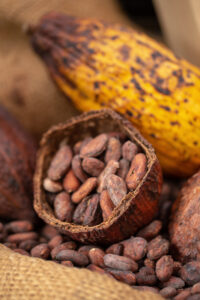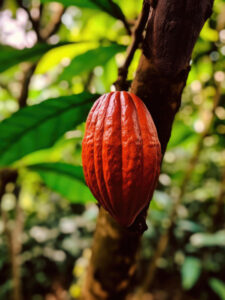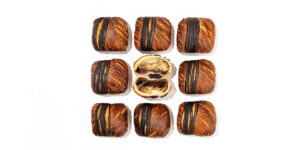Categories Pastry Chef Articles
Helen Lopez: “The price of chocolate will increase by up to 30%”

Currently, cocoa is more expensive than copper. For the first time in history, a ton costs $10,000 and the price of grain has risen 135% so far this year.
To talk about how this situation will affect the production and consumption of chocolate worldwide, we interviewed Helen López Vásquez. This journalist and lecturer specialized in chocolate culture attended the World Cocoa Conference 2024 in Brussels from April 21 to 24, one of the most important cocoa events internationally. Don’t miss out on some of her conclusions!
You have just attended a World Chocolate Conference. Tell us a little about who gathered there and for what main purpose.
This is the World Cocoa Conference that took place this year in Brussels. Actors from the entire cocoa value chain meet there, from producers, processors, marketers and governments.
What are the main concerns of the sector at the moment in your opinion?

It must be contextualized by saying that the sector, for at least a couple of decades, has been dependent on the production of African countries, mainly Ivory Coast and Ghana, although Nigeria and Cameroon are also present to a lesser extent. This means that, although there are specific problems in each country, the global concerns are these:
- High grain prices derived from factors such as the increase in illegal mining and substitution by other crops such as rubber in the main producers (Ghana and Ivory Coast).
- The effects of climate change on crops, which have not only been reduced but also affected by easily spread diseases such as monilia.
- Failure to comply with contracts by cocoa producers who can now sell to new buyers.
- Deterioration of post-harvest practices. A dynamic has entered into which the lowest quality cocoa is sold at the most expensive price.
“Climate change has affected crops all over the planet. It has been especially cruel in the Ivory Coast and Ghana and there is no producing country that can meet the demand in the short term.”
Cocoa cultivation occurs in many areas of the world, basically those with a suitable type of climate. Why are there apparently some production, supply, and price problems that can affect the entire industry without exception?
Climate change has affected crops around the planet. The problem is that it has been especially cruel in the two African countries and there is no producing country that can meet the demand in the short term. A demand that has been increasing in the last decade between 3% and 5%, to which has been added the “awakening” of new countries such as Korea, Taiwan, and even China. The issue is so serious that even large producers like Brazil, on some occasions, have to import cocoa from Africa to serve their local market.
So climate change is the main cause of the problems that the cultivation of this product has? As you say, the demand for chocolate products has grown in the world, can that also affect the price indices and the average quality of chocolates?

Climate change is one of the problems, but it is a multifactorial situation of issues that have been going on in the industry for years. Some would be the dependence on African production, the little investment that has been made in technology and plantation improvement given the almost four decades of low prices, the control of the business by some governments, and the lack of response to complaints of child exploitation.
The price is already being affected in the final product. However, producers are still using raw materials purchased in previous periods. According to experts, it will be an increase of up to 30%, although it is possible that it will be more, since inflation must also be taken into account. The Christmas campaign will be grave, the quality of mass consumption will be affected, since producers are making changes to the recipes (they will include palmin fats, cocoa powder, among others). There will also be changes in the number of references, for example, nougat with chocolate or panettone with “chocolate chips” may not be found. There will be much more presence of “analogs”, that is, products with “chocolate flavor” that use raw materials other than cocoa.
“During the Christmas campaign, the quality of chocolate in mass consumption will be affected, as producers are making changes to recipes. There will also be changes in the number of references”
It is true that talking about the chocolate industry is really complicated, since it is made up of many realities that range from the small bean to bar producer to the large industry. Does each of these sectors access cocoa at origin in a different way?
Yes, there is a differentiation between the “bulk” cocoa market and “fine” cocoa. Although the most serious situation falls on ordinary cocoa, the entire chain is affected. Small producers already pay a very high price for cocoa, but now much of the cocoa that was destined for the gourmet market will go to complete the mass consumption market. In fact, it is possible that many small producers will have to pay prices so high that their activity is unviable, so unfortunately many small chocolate shops around the world are expected to close. However, as consumer perception will change, two things will happen: a decrease in consumption, but the consumer who continues buying will be willing to buy expensive and, above all, will be stricter with quality.
“It is possible that many small producers will have to pay prices so high that their activity is unviable.”
How do some changes in the market affect, for example, a greater culture for ethically responsible and sustainable quality chocolate? Is good cocoa accessible to any small chocolate maker who wants it?

The quality of cocoa is measured in principle by production and post-harvest practices. The European Union, with the new law that will come into force at the end of this year, has already encouraged more sustainable production unrelated to deforestation. However, “traders” or large cocoa importers will have to choose which countries they will work with, not only because they are the ones that are really committed to these principles, but because it is feasible to prove the traceability of these beans.
How can this reality affect each range of chocolate products, in the large industry that manufactures derived and substitute products, in the premium chocolate sector, in the bean to bar, and in the couverture chocolates that artisans and candy makers use?
There is a card that can relax market tensions: Ghana’s next harvest. If it is good, it can partially alleviate demand. For this reason, even many large producers do not supply products for the Christmas campaign. Let’s say that this factor can ensure not all the cocoa that is needed, but at least meet that seasonal peak.
In the case of bean to bar chocolate makers, supply is easier in Europe because the volumes are small and they can use cocoa stored in Europe. However, we must remember that even in the producing country, chocolate makers pay for cocoa at the market price and in the case of fine cocoa, up to 40% is added to that price.
“There is a card that can relax market tensions: Ghana’s next harvest. If it is good, it can partially alleviate demand”
Catastrophic messages about the extinction of cocoa or the drastic reduction in its accessibility are very frequently heard in the media. Do you share those messages? What do you think the cocoa and chocolate culture will be like in 5 or 10 years?

I believe that this situation will allow for a profound review not only of the sector but also of the perception of the consumer who has been accustomed for years to one-euro chocolate bars from the supermarket. There will be a significant investment in countries that could sign up to be the new “players” such as Ecuador, Peru, and Brazil. However, it is feared that any investment made now will be impossible to recover when low prices return.
“There will be a decrease in consumption, but the consumer who continues buying chocolate will be willing to buy expensive and above all will be stricter with quality”




